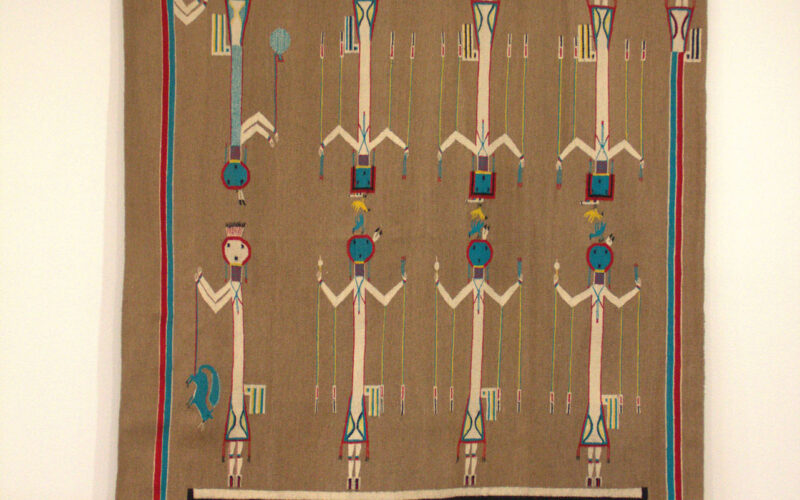BECCA MARTIN-BROWN
bmartin@nwaonline.com
Rugs have always represented both beauty and function for the Diné. Now a collection on exhibit through Jan. 31 at the Museum of Native American History in Bentonville also showcases their role in keeping the history of the Navajo people alive.
“The majority of these rug designs started as a ceremony through sand painting that the medicine man would do,” says Caitie Holt, the museum’s curator, whose ancestry is Cherokee. A medicine man “would use sandpainting to heal and restore balance to the patient and to the Bikeyah (Diné land). As this tradition was kept alive, medicine men would transition into using the textiles for their ceremonies and rituals.
“Even the act of weaving is a ritual practice for many generations of weavers as it connects them spiritually to their ancestors and deities, i.e. Spider Man and Spider Woman, creator of the loom and the First Weaver.”
“The rugs that we see here today are a small blueprint of Diné heart and soul,” adds Alaynna Littlefeather, museum shop manager, who is Diné. “Every form of art that we do, especially rug weaving, is a part of a bigger universe in how we live within the hózhó (beauty) way.
“These rugs show the earliest form of hózhó through sandpainted depictions of our creation stories,” she continues. “Without these creation stories, we can’t teach one another how to honor kinship, love, and respect each other. That’s all I feel when I look at these rugs is that timeless sense of wisdom and love that has passed down from my ancestors to me. To say these rugs are special is an understatement; they are sacred.”
The museum was gifted the rugs by Dr. Howard Cockrill, a retired radiologist from Little Rock, who began collecting after finding his first rug on a family trip to the Colorado River. The healing ceremonies depicted in the rugs resonated with Cockrill, and over time, he has donated some 60 pieces to MONAH. The textiles span the 1800s and 1900s, Holt says, from the time of the Dine people’s contact with the Spanish around 1820 to the popularity of Navajo rugs with Victorian Europeans to the establishment of the Navajo Tribal Council in 1923.
“All throughout this history, they were still making tapestries and sandpainting textiles,” says Holt. “Some would be used for trade, and others would be used for functional ceremonies within the Hogan, a gathering place for ceremonies and traditions.”
Holt of course worked closely with Littlefeather to “to bring honor to each” of the 26 textiles on exhibit.
“There was a lot of discussion about what we wanted to title the exhibition, and we landed on ‘The Way of Beauty’ as it connects with a closing prayer for the Dine,” Holt says.
“In my culture we have a closing prayer, Hózhó Náhásdlíí’, which is translated into ‘all is beautiful again,’” Littlefeather explains. “These words have always provided me with a spiritual sanctuary that only Bikeyah (Diné land) could fulfill.
“I grew up on sacred land with rooted memories of old traditions and teachings. Hózhó Náhásdlíí’ is a promise to oneself that we will continue to live the life our ancestors intended; full of health, wisdom, safety, and peace. To live by these principles means we continue the Hózhó way — the Diné way. These weavings are a physical proof of that sacred promise.”
The title “The Way of Beauty” pays homage to Hózhó Náhásdlíí’, Littlefeather says.
“After viewing each piece and its craftmanship, I hope others can agree that the Diné weavers had this prayer in mind as well. ”
The rugs are on exhibit in a new MONAH facility, a 1,330-square-foot activity center at 214 S.W. “O” St. Jazlyn Sanderson, museum director, says the space will be used for upcoming exhibitions, events and rental space for the community.
“People can see this space as an extension of the museum galleries when we host temporary exhibitions,” she says. “Tour groups and school field trips may also use this space as a place of gathering before or after their visit to MONAH. The community can also rent out this space for different functions, and the proceeds go back to supporting the museum. I am excited to see this as a constantly evolving space ready to adapt to whatever it needs to be!”
Although the rugs will be retired to “rest” after the exhibit closes Jan. 31, Holt plans to bring them back to the event center and to other spaces in the main building to “keep visitors intrigued and to continue sharing the stories of the Diné people, as the rugs are beautiful.”
__
FAQ
‘The Way of Beauty: Diné Woven Stories’
WHEN — Through Jan. 31; 2 to 4 p.m. Tuesday-Saturday
WHERE — Museum of Native American History event center in Bentonville
COST — Free
INFO — monah.org
FYI — The museum store will feature many Diné artists during the exhibition run, specifically jewelry with textile motifs, and also books on weaving.



